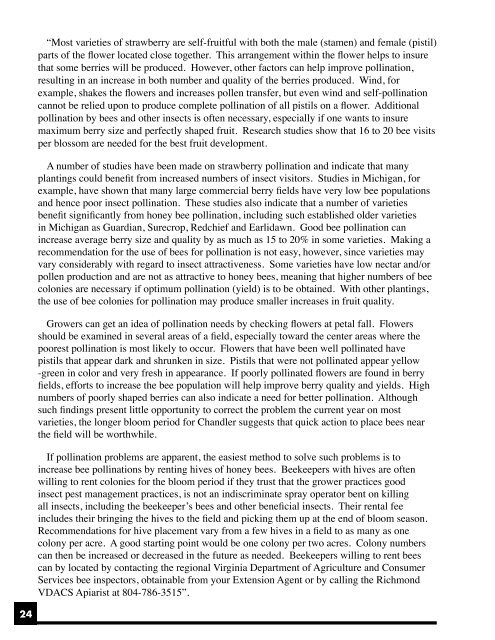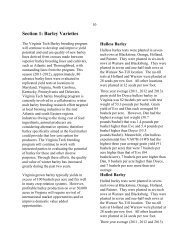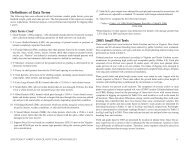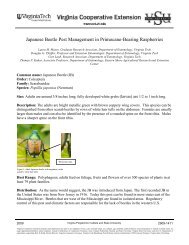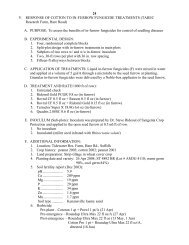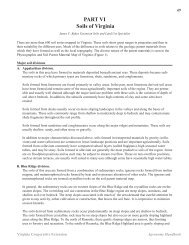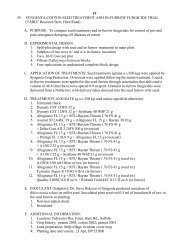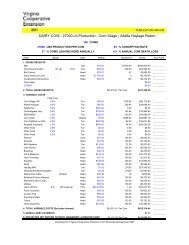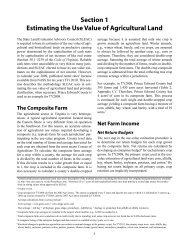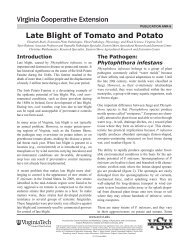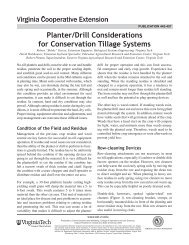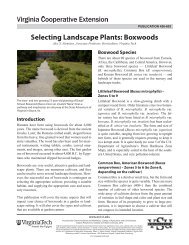PDF (1 MB) - Virginia Cooperative Extension - Virginia Tech
PDF (1 MB) - Virginia Cooperative Extension - Virginia Tech
PDF (1 MB) - Virginia Cooperative Extension - Virginia Tech
You also want an ePaper? Increase the reach of your titles
YUMPU automatically turns print PDFs into web optimized ePapers that Google loves.
“Most varieties of strawberry are self-fruitful with both the male (stamen) and female (pistil)<br />
parts of the flower located close together. This arrangement within the flower helps to insure<br />
that some berries will be produced. However, other factors can help improve pollination,<br />
resulting in an increase in both number and quality of the berries produced. Wind, for<br />
example, shakes the flowers and increases pollen transfer, but even wind and self-pollination<br />
cannot be relied upon to produce complete pollination of all pistils on a flower. Additional<br />
pollination by bees and other insects is often necessary, especially if one wants to insure<br />
maximum berry size and perfectly shaped fruit. Research studies show that 16 to 20 bee visits<br />
per blossom are needed for the best fruit development.<br />
A number of studies have been made on strawberry pollination and indicate that many<br />
plantings could benefit from increased numbers of insect visitors. Studies in Michigan, for<br />
example, have shown that many large commercial berry fields have very low bee populations<br />
and hence poor insect pollination. These studies also indicate that a number of varieties<br />
benefit significantly from honey bee pollination, including such established older varieties<br />
in Michigan as Guardian, Surecrop, Redchief and Earlidawn. Good bee pollination can<br />
increase average berry size and quality by as much as 15 to 20% in some varieties. Making a<br />
recommendation for the use of bees for pollination is not easy, however, since varieties may<br />
vary considerably with regard to insect attractiveness. Some varieties have low nectar and/or<br />
pollen production and are not as attractive to honey bees, meaning that higher numbers of bee<br />
colonies are necessary if optimum pollination (yield) is to be obtained. With other plantings,<br />
the use of bee colonies for pollination may produce smaller increases in fruit quality.<br />
Growers can get an idea of pollination needs by checking flowers at petal fall. Flowers<br />
should be examined in several areas of a field, especially toward the center areas where the<br />
poorest pollination is most likely to occur. Flowers that have been well pollinated have<br />
pistils that appear dark and shrunken in size. Pistils that were not pollinated appear yellow<br />
-green in color and very fresh in appearance. If poorly pollinated flowers are found in berry<br />
fields, efforts to increase the bee population will help improve berry quality and yields. High<br />
numbers of poorly shaped berries can also indicate a need for better pollination. Although<br />
such findings present little opportunity to correct the problem the current year on most<br />
varieties, the longer bloom period for Chandler suggests that quick action to place bees near<br />
the field will be worthwhile.<br />
If pollination problems are apparent, the easiest method to solve such problems is to<br />
increase bee pollinations by renting hives of honey bees. Beekeepers with hives are often<br />
willing to rent colonies for the bloom period if they trust that the grower practices good<br />
insect pest management practices, is not an indiscriminate spray operator bent on killing<br />
all insects, including the beekeeper’s bees and other beneficial insects. Their rental fee<br />
includes their bringing the hives to the field and picking them up at the end of bloom season.<br />
Recommendations for hive placement vary from a few hives in a field to as many as one<br />
colony per acre. A good starting point would be one colony per two acres. Colony numbers<br />
can then be increased or decreased in the future as needed. Beekeepers willing to rent bees<br />
can by located by contacting the regional <strong>Virginia</strong> Department of Agriculture and Consumer<br />
Services bee inspectors, obtainable from your <strong>Extension</strong> Agent or by calling the Richmond<br />
VDACS Apiarist at 804-786-3515”.<br />
24


